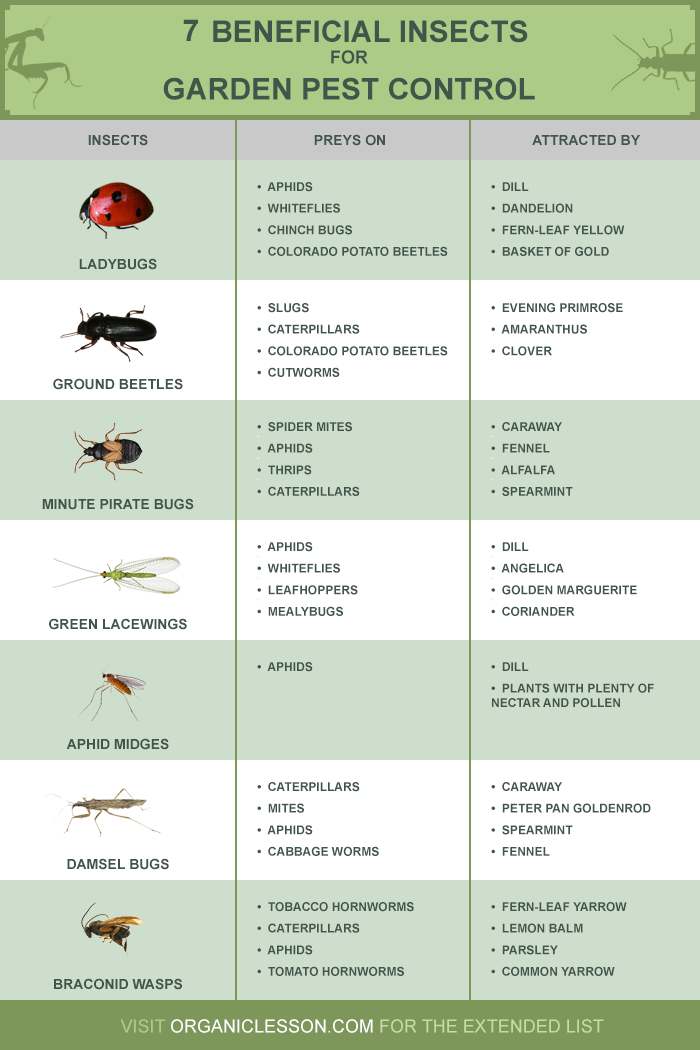| Aphids | Green Lacewings, Hoverflies, LadybugsGreen Lacewings How to Attract: Larvae are called "aphid lions." Attract adults by planting cosmos, angelica, and coreopsis. You can also purchase lacewing eggs to release in your garden. Hoverflies How to Attract: The larvae are slug-like and devour aphids. Adult flies are pollinators that look like small bees. Attract them with sweet alyssum, parsley, and yarrow. Ladybugs How to Attract: Plant dill, cilantro, yarrow, and sweet alyssum. Avoid pesticides, which kill their larvae (the heaviest feeders). A small patch of dandelions can also attract them. |
| Cabbage Worms | Braconid Wasps, Trichogramma WaspsBraconid Wasps How to Attract: Similar to Trichogramma wasps, they parasitize caterpillars. Attract them with plants from the carrot family (dill, fennel) and aster family (daisies). Trichogramma Wasps How to Attract: These tiny wasps lay eggs inside pest eggs. Attract them with small-flowered nectar plants like dill, parsley, sweet alyssum, and Queen Anne's Lace. |
| Cucumber Beetles | Tachinid FliesTachinid Flies How to Attract: These flies parasitize the adult beetles. Attract them by planting dill, parsley, and other members of the carrot family. |
| Cutworms | Ground Beetles, Predatory NematodesGround Beetles How to Attract: These nocturnal predators will hunt cutworms on the soil surface at night. Provide shelter for them with rocks, logs, or dense ground cover. Predatory Nematodes How to Attract: Purchase and apply Steinernema carpocapsae nematodes to the soil. They actively hunt down cutworms below the surface. Keep soil moist after application. |
| Fungus gnats | Beneficial Nematodes, Hypoaspis MilesBeneficial Nematodes How to Attract: Ideal for houseplants and greenhouses. Apply to moist soil. The nematodes enter the larvae and eliminate them, breaking the life cycle. Hypoaspis Miles How to Attract: A soil-dwelling mite that feeds on fungus gnat larvae. Purchase and release onto the soil surface of pots or garden beds. |
| Grasshoppers | Spiders & BirdsSpiders & Birds How to Attract: Attract birds with feeders, birdbaths, and shrubs for cover. Encourage spiders by mulching. A healthy, diverse ecosystem is the best defense. |
| Japanese beetles | Beneficial Nematodes, Milky Spore BacteriumBeneficial Nematodes How to Attract: Apply Heterorhabditis bacteriophora nematodes to your lawn in late summer when grubs are most active. Water the lawn well before and after application. Milky Spore Bacterium How to Attract: This is a long-term soil treatment, not an insect. Apply milky spore powder to your lawn. It infects and kills the grubs, reducing future beetle populations. |
| Mealybugs | Mealybug DestroyerMealybug Destroyer How to Attract: This specialized lady beetle is a voracious predator of mealybugs. Attract them with plants from the sunflower family like daisies, asters, and sunflowers. |
| Scale Insects | Ladybugs, Parasitic WaspsLadybugs How to Attract: Especially effective against soft scale. Create a welcoming habitat with flowering herbs and avoid the use of broad-spectrum pesticides. Parasitic Wasps How to Attract: Many tiny wasp species parasitize scale. Plant umbel-shaped flowers like dill, fennel, and Queen Anne's Lace to provide nectar for the adult wasps. |
| Slugs & Snails | Ground Beetles, Rove BeetlesGround Beetles How to Attract: Provide shelter with rocks, logs, mulch, or low-growing perennial ground cover such as creeping thyme or ajuga. These nocturnal hunters will hide during the day and hunt at night. Rove Beetles How to Attract: Attracted to compost piles and decaying organic matter. Maintaining a healthy compost area can provide a habitat for these predators. |
| Spider Mites | Minute Pirate Bugs, Predatory MitesMinute Pirate Bugs How to Attract: These generalist predators also eat thrips and aphids. Attract them by planting goldenrod, yarrow, and alfalfa in or near your garden. Predatory Mites How to Attract: Purchase and release specific species like Phytoseiulus persimilis. They thrive in high humidity; misting plants can help them and deter spider mites. |
| Squash Bugs | Spiders, Tachinid FliesSpiders How to Attract: Encourage spiders by mulching and avoiding excessive tidiness. They are fantastic generalist predators that will catch squash bug nymphs. Shrubs like lilac and small fruit trees also provide excellent habitat. Tachinid Flies How to Attract: These flies lay their eggs on adult squash bugs. The larvae then burrow into the host. Attract them with dill, parsley, clover, and other herbs in the carrot family. |
| Thrips | Minute Pirate Bugs, Predatory MitesMinute Pirate Bugs How to Attract: A key predator for thrips. Plant caraway, fennel, spearmint, and goldenrod to provide them with nectar and shelter. Predatory Mites How to Attract: These mites are excellent for controlling thrips, especially in greenhouses or on houseplants. They are often purchased and released directly onto affected plants. |
| Tomato Hornworms | Braconid WaspsBraconid Wasps How to Attract: If you see a hornworm with white, rice-like cocoons on its back, leave it! It's a nursery for new wasps that will hunt more hornworms. Plant dill and parsley to feed the adults. |
| Whiteflies | Ladybugs & Lacewings, Parasitic WaspsLadybugs & Lacewings How to Attract: These generalist predators also eat whiteflies. Plant a diverse range of flowering herbs and flowers, such as fennel and cosmos, to attract a variety of helpers. Parasitic Wasps How to Attract: A specialist predator often used in greenhouses. Attract them and other parasitic wasps by planting marigolds, zinnias, and sweet alyssum. |

